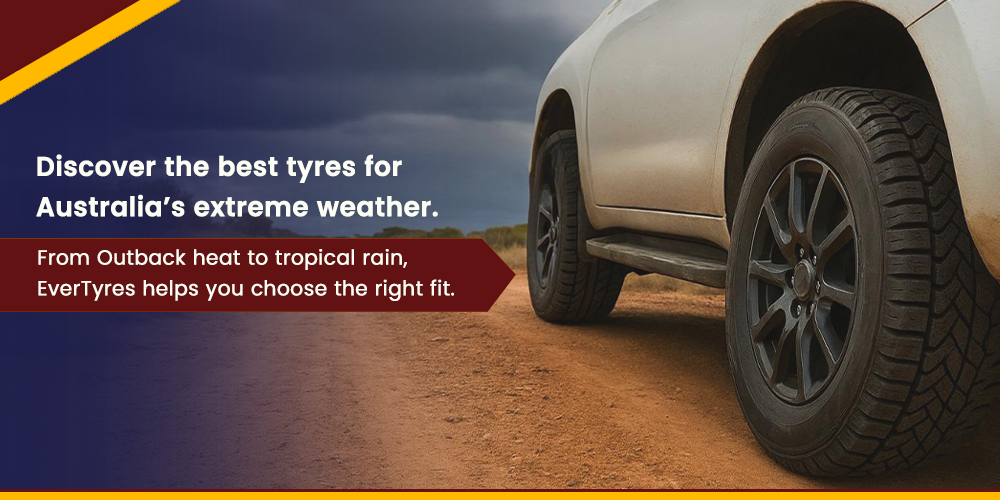
Key Takeaways
• Climate matters: Tyres behave differently in Outback heat, tropical rain, snow, coastal salt, and city driving.
• Choose for your main environment: All-terrain for mixed conditions, wet-weather tyres for tropical areas, winter tyres for alpine regions, and touring tyres for city use.
• Maintenance is crucial: Regular pressure checks, rotations, alignments, and rinsing after sandy or salty drives extend tyre life.
• Safety comes first: Tyre tread depth, correct inflation, and the right compound can prevent blowouts and improve grip in extreme conditions.
• EverTyres makes it easy: Browse and buy quality tyres online tailored for Australia’s diverse driving environments.
Australia is a land of contrasts. You could be driving through scorching red dirt in the Outback one week,
then navigating wet and slippery coastal roads the next. For your car, that means one thing — your tyres
need to handle it all. While most drivers think of tyres as just “rubber on wheels,” the reality is that
Australia’s extreme weather conditions can have a huge impact on their performance, safety, and
lifespan.
In this guide, we’ll explore how different climates across Australia affect your tyres, what you can do to
protect them, and how to choose the right set for wherever the road takes you.
Outback Heat: Tyres Under the Sun’s Harshest Test
There’s nothing quite like an Australian summer in the Outback 40°C days, shimmering heat haze, and roads so hot you could fry an egg. These extreme temperatures can cause tyre pressure to rise rapidly, leading to overinflation, uneven wear, or even blowouts.
Long stretches of rough, unsealed roads add another challenge: sharp rocks and corrugations that can slice or bruise the sidewalls. This is where choosing All-Terrain Tyres becomes essential. Designed with reinforced sidewalls and heat-resistant compounds, they handle both the searing heat and rugged terrain far better than standard road tyres.
Pro Tip: Always check your tyre pressure early in the morning before driving. This gives you the most accurate reading before heat expansion skews the numbers.
Tropical Rain: Wet Roads and Sudden Storms
Drive through Far North Queensland in the wet season, and you’ll know just how quickly the weather can change. One minute it’s clear, the next you’re pushing through sheets of rain that turn roads into rivers.
In these conditions, tyre tread depth becomes your best defence against aquaplaning. Worn-out tyres lose their ability to channel water away from the contact patch, meaning less grip and longer stopping distances. If you live in or travel to tropical regions, consider High-Performance Wet Weather Tyres with deep grooves and advanced silica compounds for better grip on wet surfaces.
Pro Tip: Rotate your tyres regularly so they wear evenly, keeping tread depth consistent across all four wheels.
Snowy Highlands: Grip in the Cold
While Australia isn’t known for harsh winters, the alpine regions of Victoria, New South Wales, and Tasmania can still see icy roads and snowfall. Cold weather makes rubber less flexible, which reduces traction especially on steep inclines or sharp turns. For drivers heading to the snow season, Winter Tyres or all-weather tyres with a winter rating can make a huge difference in safety. These tyres are designed to stay soft in low temperatures, giving you better control and grip.
Pro Tip: Even if your tyres are winter-rated, carry snow chains if required by local regulations especially on mountain passes.
Coastal Drives: Salt, Sand, and Sea Breezes
A beach drive might sound like a dream, but the combination of salty air, loose sand, and fluctuating moisture can take a toll on your tyres. Salt can accelerate corrosion on steel belts inside tyres, while sand can cause micro-abrasions in the rubber over time. If you’re regularly hitting coastal tracks, All-Terrain or Mud-Terrain Tyres are the smarter choice. Their chunkier tread patterns help prevent you from getting bogged down, and their tougher construction withstands sand abrasion better than standard road tyres.
Pro Tip: After driving on the beach, rinse your tyres (and underbody) with fresh water to remove salt and sand.
Urban Heat and Stop-Start Stress
It’s easy to think city driving is easy on tyres, but stop-start traffic in hot summer conditions can actually
wear them out faster. Short bursts of braking and acceleration cause localised heat build-up, while
frequent cornering puts stress on the tread edges.
If most of your driving is in metro areas, Touring Tyres offer a good balance between comfort, fuel
efficiency, and longevity. They’re designed for smooth bitumen and frequent stops without sacrificing
grip.
Pro Tip: Check your alignment regularly city potholes and kerb scrapes can throw it out, leading to uneven wear.
How to Choose the Right Tyre for Australia’s Changing Conditions
The key to surviving Australia’s extreme weather isn’t finding a “perfect” tyre for all conditions, but
choosing one that suits your primary driving environment while still handling occasional extremes.
For
example:
• If you mostly drive in the Outback but occasionally visit the coast, go for heat-resistant all-terrain
tyres.
• If you live in a tropical area, prioritise wet-weather performance.
• If you split your time between city and country, consider hybrid touring tyres.
Browse our full range of quality tyres online at EverTyres to find the right fit for your vehicle and climate.
Final Word:
Respect the Conditions, Respect Your Tyres From the blistering heat of the Simpson Desert to the sudden downpours of Cairns, Australia’s climate demands tyres that can take a beating and still keep you safe. Regular checks, the right tyre choice, and timely maintenance are your best defences against breakdowns and accidents. Your tyres are the only part of your vehicle that actually touch the road. Treat them well, and they’ll return the favour no matter what weather Australia throws your way.


